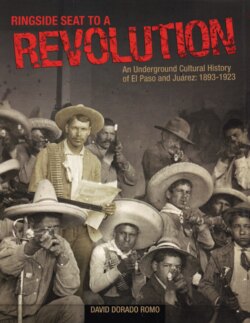Читать книгу Ringside Seat to a Revolution - David Dorado Romo - Страница 48
На сайте Литреса книга снята с продажи.
Оглавлениеactivity. Three days after rebels attacked Nogales
shouting “¡Viva La Santa de Cabora!,” the El Paso
police broke up a meeting at the Urrea house of
about 65 insurrectos planning further raids.93 On
September 23, two U.S. deputy marshals saw
Teresista leader Pomposo Ramos Rojo arrive in El
Paso by train. According to the American agents,
Teresita’s younger brother met Ramos Rojo at the
Southern Pacific depot and escorted him to the Urrea
home.94 Weeks later, after Pomposo was arrested for
leading a failed attack on Palomas, he accused
Teresita of being directly involved in the armed upris-
ing. He told the American agents who arrested him
that Teresita had helped him camouflage one of the
revolutionaries hiding in her home. He and Teresita
painted the rebel’s face and hands with black dye.
Pomposo also told the American authorities that
Teresita, Lauro Aguirre and Tomás Urrea helped plan
the Palomas raid. The planning took place while he
hid at their El Paso home.95
A few of the agents who gathered information for
the Mexican government claimed to be doctors. A
certain Dr. Williams told the local newspapers that he
gathered information that he turned over to the
Mexican consul showing that Teresita was indeed a
revolutionist.96 A second man calling himself Dr.
Thomas Bulmer said he had attended revolutionary
meetings pretending to be in sympathy with Teresita
while sending information to be used against her to
Consul Mallén.97
There were several other agents whose identity
was never uncovered by the local newspapers whose
reports are now stored in Mexican government
archives. These agents sent dispatches from El Paso
informing the Mexican government that Teresita abet-
ted the revolution in several ways. She exhorted the
insurrectos, prayed for them, told them not to fear for
their lives, gave them photographs and scapulars of
herself and raised funds for the revolution. According
to another report, she even blessed their rifles before
they entered battle.98
It’s difficult to judge just how accurate any of
these reports were. Some of these secret agent
accounts may have been fabricated or exaggerated,
merely telling Díaz officials what they wanted to hear.
But there are too many reports, from both friends and
foes, saying that Lauro Aguirre was not the only one
behind the Teresista movement.
The preponderance of evidence suggests that
despite her public denials, Teresita Urrea knew about,
supported and “quietly helped prepare the struggle”
against the government of Porfirio Díaz.
TERESITA’S FAMILY BELIEVED that some of
the agents who hovered around the Urrea home were
interested in more than just information—they want-
ed to either kidnap Teresita or kill her. Twelve armed
men were placed in front of her home to protect her.
Despite this precaution, on January 11, 1897, the El
Paso newspapers reported that a Mexican assailant
attempted to stab Teresita Urrea with a knife.
The man grasped her by the wrist but the
weapon caught in his clothes. Teresita’s followers
inside the house made a rush for the man. The
would-be assassin escaped. The Mexicans of El Paso
believed that the government of Mexico was behind
the assassination attempt.99
In April 1897, Don Tomás decided to move to
what he considered a safer zone farther from the
international border. Their new home was in the part
of town just below the Mesa Gardens (near today’s El
Paso Historical Society on Yandell Street), “away from
the Second Ward, where cheap secret agents and ex-
deputy constables have been nosing around her
house,” the El Paso Times reported. “The girl seems to
be overworked and shows slight signs of failing
health. Tomás has an ugly looking pistol that lies near
his grasp so that he can be prepared to promptly
meet any more attempts on the young lady’s life.”100
The El Paso newspaper quoted a Teresita deeply
troubled and tired of the incessant political persecu-
tion. “I do not see why people are always troubling
me. I do no one harm, but instead try to do good. I
want no one punished for evils here, but know that
all will reap their just rewards hereafter.”101
But by the summer of 1897, the Urrea family had
had enough. They decided to put much more dis-
tance between themselves and the border and reset-
tle in Clifton, Arizona. This time Lauro Aguirre would
not follow Teresita. He would stay behind and con-
tinue to be the lonely voice in the El Paso wilderness,
fomenting revolution even without her. Teresita and
43
93
Ibid., p. 42.
94
El Paso Times, September 23, 1896.
95
Domecq, “Teresa Urrea,” in Vargas’ Tomóchic: La revolución adelantada, pp. 39-40.
96
El Paso Times, September 11, 1896.
97
El Paso Times, September 20, 1896.
98
Lilián Illades, “Teresa Urrea y Lauro Aguirre,” essay published in Vargas’ Tomóchic: La revolución adelantada, p. 83.
99
El Paso Herald, January 12, 1897.
100
El Paso Times, April 23, 1897.
101
Ibid.
